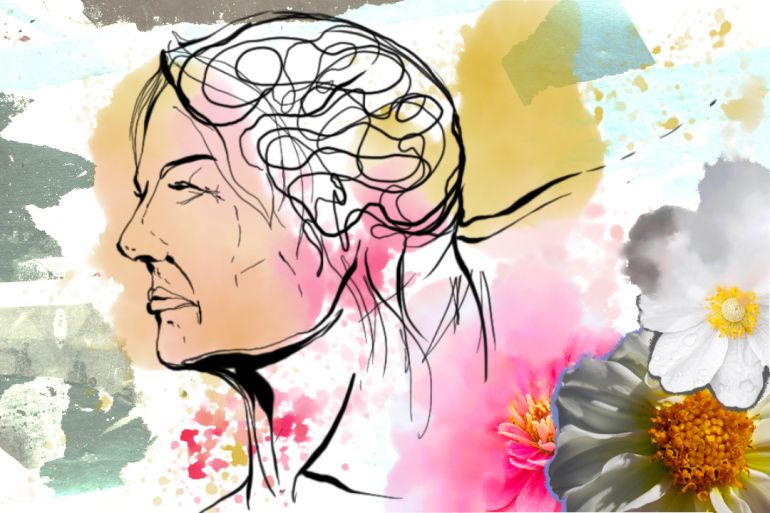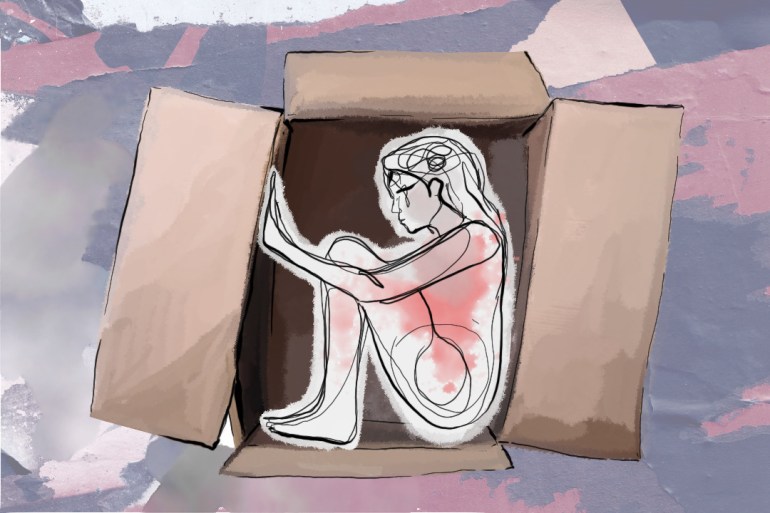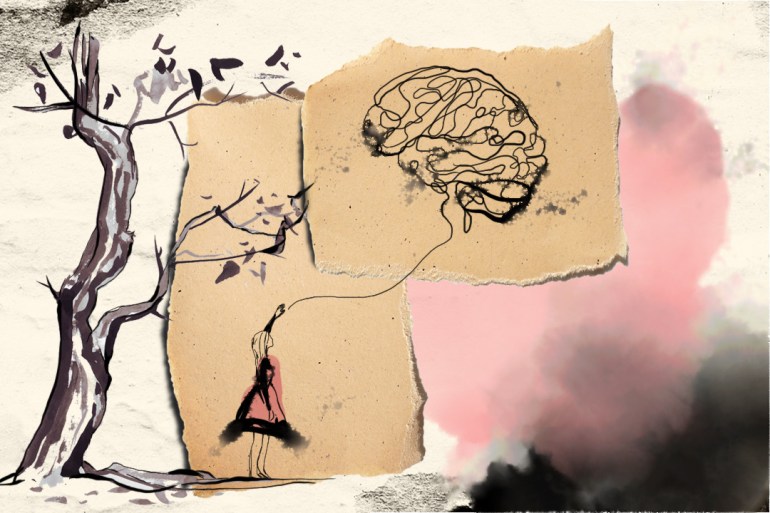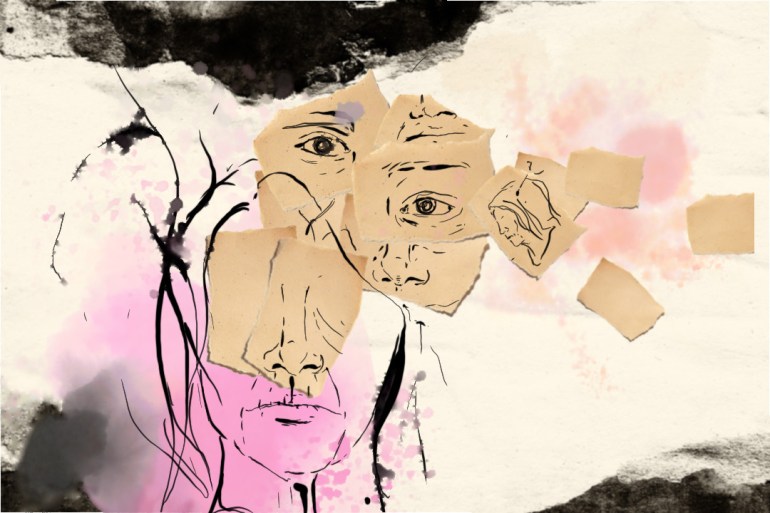Dying of loneliness: How COVID-19 is killing dementia patients
Elderly people living in care homes are not just dying from coronavirus; they are dying because of the response to it.

Teresa Palmer is sitting on the back porch of her home in San Francisco when the mobile phone in her hand starts to buzz.
A kind, raspy voice inquires from the other end of the line: “Did I wake you?” If the question surprises Palmer, she does not show it. Her reply is plain and swift. “No,” she says: It is past one in the afternoon. She has been awake for hours.
Keep reading
list of 4 itemsUK dementia patients face challenges during lockdown
For some elderly Italians, loneliness brings more fear than virus
UK’s elderly struggle with COVID-19 isolation
Her mother, Berenice Palmer, is 103 years old. She lives at the San Francisco Campus for Jewish Living, a 15-minute drive south from the cheery blue house where Teresa, 68, and her husband live.
But since March, Teresa has not been able to see Berenice, except for the occasional doctor’s visit, plus that one time Berenice fell and had to get stitches at the emergency room. Teresa was given permission to drive her mother back to the nursing home.
Otherwise, all visitation stopped. Until September, even outdoor visits and window visits – where a patient looks through a window to see a loved one outside – were barred under measures the San Francisco Department of Public Health implemented to stop the spread of the novel coronavirus.
It was a devastating development for dementia patients like Berenice, for whom routine interaction and careful observation are key.
Commonly characterised by a deterioration in memory, thinking and language skills, dementia is a syndrome that can result from any number of diseases or injuries to the brain. Sometimes it is Alzheimer’s. Sometimes a stroke. Sometimes something entirely different.
It is so common, especially among older adults, that the World Health Organization (WHO) estimates that upwards of five percent of the world population over the age of 60 lives with dementia. That is approximately 50 million people worldwide.
Berenice is among the more than 5.8 million with the syndrome in the United States. And today, she is worried. She wants her daughter to find the box with her medical records. She fears her cancer might have returned.
Teresa, herself a retired nursing home doctor, calms her down. She has heard these anxieties before. She is more alarmed to hear Berenice say she has been refusing her salt pills: “They taste bad.”
Instantly, Teresa switches into doctor mode. No more “Mom”: She calls Berenice by her first name, asking her, imploring her, to give straight answers. Berenice has low blood sodium, which can lead to confusion and even seizures. The pills are there to help.
It was Berenice who instilled in Teresa a passion for medicine. A born storyteller from a big Italian family, Berenice came of age during World War II, serving in the United States Naval Reserve, a women’s-only branch of the military often called “WAVES” for short.
Berenice would go on to raise two children – Teresa and her twin brother – while pursuing a career as a licensed vocational nurse and community journalist. As a child, she had survived a diphtheria epidemic. She had seen the poliovirus come and go. Teresa was determined she would outlive COVID-19 too.
‘I was just so afraid my mother would die’
Back on her porch, Teresa tells her mother she will call her back. A second later, she is on the phone with the nursing home. No need to introduce herself beyond “Berenice’s daughter”: The woman who picks up instantly recognises her. They talk strategy. Mixing the salt pills in yoghurt has not worked. What about apple sauce?
Feeling reassured, Teresa rings her mother again. They talk at least once a day. “She, unlike others, is alert enough to call me when she has a complaint. And sometimes she calls me instead of the nurses,” Teresa explains. They chat about dinner plans. Teresa promises to order her mother a pizza.
Her mother has increasing difficulty dialling phone numbers, though. She relies on the operator to connect her instead. But even that is a blessing, Teresa says. “God help the people who can’t.”

Since the start of the coronavirus pandemic, nursing homes and other communal living facilities have been particularly hard hit, with the virus spreading more easily in confined spaces. The elderly are especially vulnerable.
But for those living with dementia, the threat comes not only from COVID-19 itself but from the very same practices meant to stop it, like quarantining. The Alzheimer’s Society in the United Kingdom reports that 82 percent of dementia patients surveyed showed deterioration since lockdown measures were put in place. That includes memory loss, difficulty concentrating and increased agitation.
And in the US, between February 1 and October 9 of this year, the Centers for Disease Control and Prevention reported 30,248 more dementia-related deaths than average, compared to data from 2015 through 2019.
Experts fear that isolation and lack of supervision, plus an overburdened healthcare system, may be contributing to the excess deaths. “It’s such a mess that we have to rethink how we do this, completely,” Teresa says. “I was just so afraid my mother was going to die.”
The decision Teresa took to place her mother in a nursing home four years ago was not an easy one. Teresa was suffering from complications of rheumatoid arthritis. Her mother was living in her spare room, and she needed constant attention. Left alone, Berenice could wander out onto the street. She could not remember whether it was day or night.
“My husband and I were both exhausted and had no privacy,” Teresa explains. Hired caregivers would come in and out of the house, and Berenice, always the extrovert, loved to be the centre of attention. “If we would try to have a conversation about something else, she would interrupt us.”
As her medical needs grew too great to handle at home, Berenice went to live at the San Francisco Campus for Jewish Living. There, Teresa says, her mother had group activities and other outlets to share her outgoing personality. But much of that interaction stopped with the pandemic.
Teresa first found out that visitors were barred when a friend tried to stop by. “He came back on that Friday, on March 10, and said, ‘They won’t let me in. They shut down’. And that was the first I’d heard of it,” she says.
Suddenly, she no longer had a means to check her mother’s condition. And as a doctor-turned-activist, Teresa knew the risks that came with long-term living facilities. Individualised care is key, especially for patients with later-stage dementia. “They never look or act normal. So, you have to know them pretty well to know when they are worse than normal.”
Even before the pandemic, Teresa says it was crucial for families to be as involved as possible in a loved one’s care. “We have a joke in medicine. You write on the physical exam ‘WNL’: within normal limits. But the other abbreviation is: ‘We never looked.'”
Isolation, depression and weight loss
Lawyer Anthony Chicotel is a colleague of Teresa’s at the California Advocates for Nursing Home Reform. He says the top priority now is increasing visitation rights, for the benefit of both long-term care residents and their families.
“People are dying from COVID-19 who didn’t have the virus. They’re dying because of the response that we had related to COVID-19. It might be the isolation, depression, the weight loss, the lack of supervision and observation that normally these people would have,” Chicotel says. “The lack of family involvement that they would normally have is hurting people and killing some of them, particularly those with dementia.”
Chicotel admits to feeling a certain “impotence” since the pandemic began. He says it has become increasingly difficult to influence healthcare policy.
First, there has been what he calls a “balkanisation” of public health. Normally, Chicotel would concentrate on lobbying state and federal officials. But these days, cities, counties and even individual facilities have their own COVID-19 rules. “It’s been really hard to get a grasp on everything as efficiently as we could in the past.”
Then, there is the idea that governments should stop the virus at any cost – even if it means suspending the rights of individuals in long-term care, Chicotel says.
“I think it is, to some extent, ageism rearing its head,” he explains. “We’re just, as a society, used to telling older people what’s best for them and forcing them to accept it. We just haven’t seen the same kinds of restrictions on childcare, for example, that we’ve seen with elder care.”
Chicotel considers the restrictions “the biggest civil rights tragedy” in the history of long-term care in the US. And he fears it may only get worse, as facilities relax staffing requirements and residents remain cut off from their loved ones.
“Are these policies actually benefitting as much as we thought they would? Probably not. Are they costing more than we thought they would? As time goes along, absolutely they are,” he says.
One outcome Chicotel predicts will be a rise in prescriptions for so-called “chemical restraints” – drugs used to control the behaviour of patients.
With healthcare staff stretched thin during the pandemic, it may be increasingly tempting to use behaviour-altering drugs for convenience rather than necessity – especially, Chicotel says, “with fewer people to notice that mom or dad is constantly sleeping all of a sudden”.
A ‘perfect storm’ of healthcare shortcomings
Ann Kolanowski, a retired professor of nursing and psychiatry at Penn State University, calls what is happening a “perfect storm” of healthcare shortcomings. Many of the issues facing dementia patients have been long-standing, she explains, but the pandemic has brought them into sharp relief.
Nursing homes in particular – where a majority of dementia-related deaths in the US took place even before the pandemic – were shown to have a “terrific lack of sufficient staff, particularly those with infection control expertise,” Kolanowski says.
They also lacked basic personal protective equipment (PPE) like masks and their infrastructure proved largely outdated.
Then, there was the rift in priorities. “What COVID brought to light is this tension that we have between infection control using social isolation – because that’s really our major treatment right now – and quality of life. And this tension is huge. It affects the nursing home residents. It affects staff as well as families,” Kolanowski says.
But Kolanowski argues that preventing infection and providing individualised care do not have to be mutually exclusive. It all comes down to educating family members to be part of the care system – and providing adequate resources for staff.
Nursing home workers often contend with low wages that force them to work in multiple long-term care facilities. Staff turnover is high. Add to that meagre, if any, sick leave, and Kolanowski sees a recipe for carrying the virus from facility to facility, “exponentially causing more transmission”.

Many of these employees care deeply for the dementia patients they look after, Kolanowksi says. Their patients’ deaths can feel like a personal loss. “It’s not like a hospital where you have somebody come in and they’re there for a few days, maybe a week, and then they go home. These are people they’ve known for years. So they are like family.”
It is part of a shift in care practices that Kolanowski has seen since she first graduated from college in 1970. Back then, there was little understanding of neurodegenerative diseases like dementia. Nursing homes were modelled on hospitals. Patients were written off as confused or senile.
“We’re not a society that necessarily values older people, and people with dementia in particular,” she says. While Kolanowski admits our understanding of dementia has come a long way since then, she remains concerned that the need for individual care is still being neglected.
Nursing homes in the US, for instance, are not required to have a registered nurse on staff at all times – something Kolanowski believes is crucial “to take care of these complex people who have complex medical needs”.
‘Some people will only eat when a relative feeds them’
“You can’t think about dementia without thinking about caregivers,” says Marina Martin, chief of geriatrics at the Stanford School of Medicine. “Because dementia means you’re going to need caregivers.”
Martin, like many healthcare professionals, has found herself in a bind. There is no substitute for seeing a patient in person, she says. She can check for new wounds, observe how they move, gauge their reactions. But at the same time, going from room to room to see patients simply is not an option with a virus as contagious as COVID-19.
Even the most basic protective equipment has also proved to be a barrier. “When I go to see my patients with significant dementia, they may not understand why I’m wearing all this stuff on my face,” Martin says, referring to the face shield and N95 mask that now form part of her uniform. “So I try to explain it a little bit. But I get more blank looks or quizzical looks than I used to.”
Likewise, patients sometimes forget why they are wearing a mask too. “They might put it on their forehead. I’ve seen all kinds of things,” she says.
Still, for all the difficulties, Martin is confident that healthcare professionals and families can collaborate to keep coronavirus transmission low, while still providing in-person support for dementia.
These patients cannot wait two years for isolation practices to end, Martin says. They need visitation, however limited, now. “Some people really will only eat when their family member feeds them. I have had two patients with that situation in one of the buildings where I work.”
Digital divide another barrier
Esther Oh, co-director of the Johns Hopkins Memory and Alzheimer’s Treatment Center in Baltimore, Maryland, has found telemedicine – remote care through digital services like Zoom – to be promising though, for certain individuals living with dementia.
Ordinarily, she estimates her centre receives 2,500 visits each year. Many of her patients are not in nursing homes but rather in independent living communities or family homes.
“Of course, I used to be a firm believer in in-person visits only,” she says. But when the pandemic started to spread, her methods had to adapt. “We went from 100 percent in-person visits only – we didn’t do any telemedicine – to 100 percent telemedicine from the third week of March.”
The first week, Oh recalls that none of her patients chose to use video conferencing software. They preferred the telephone. Oh suspects the technology was unfamiliar and therefore, scary.
But as time went on, she saw some caregivers and patients embracing video calls. It was more convenient for patients who otherwise had to travel long distances and caregivers who could sometimes spend hours helping a loved one out of bed.
Since the initial stay-at-home orders relaxed, Oh says she is now back to seeing approximately 80 percent of her patients in-person again. But she also continues to offer telemedicine to those who prefer it.
Video conferencing online allows Oh’s patients to see her full face, without a mask, which helps especially when a patient has hearing problems. Plus, they can invite their loved ones to attend their appointments too, as opposed to in-person visits, where only one individual can enter the exam room at a time.
“All their children from out of state can actually Zoom in. So they really like that,” Oh says. “It’s literally a Zoom click away. So sometimes we have four or five faces on the screen.”

Still, it is no silver bullet. Some people living with dementia find video conferencing acutely distressing. And for a certain segment of the population – one that includes both patients and caregivers alike – a digital divide exists: They lack the access to technology that would make video conferencing even possible.
“We just assume everybody has an iPhone or an Android,” Oh says. “Even if you provide somebody with a mobile device, they would have to have a data plan or Wi-Fi and know-how, in terms of how to download Zoom. So it’s actually a really complicated process. When I do webinars now for caregivers, I do wonder who is not there.”
‘This is new. And I’m blaming it on COVID’
Pamela Montana and her husband, Bob Linscheid, of Danville, California, work to represent the voices of those living with dementia and their caregivers. They serve on the Governor’s Task Force on Alzheimer’s Prevention and Preparedness in California.
Their expertise comes from first-hand experience. Montana, 65, was diagnosed with younger-onset Alzheimer’s disease in 2016. Her dementia changed both of their lives.
She first noticed something was wrong while she was at work. Montana had a high-pressure job at Intel, the US technology company, that often required her to multitask. “At Intel, you had to or you wouldn’t make it,” she explains.
But she started to notice at staff meetings that she wasn’t able to absorb what was going on any more. “I had to write down almost every word they said, to let it sink into my brain,” she says. “I cognitively wasn’t grabbing it.”
Linscheid started to observe changes, too. He had known Montana since the 1970s when she was an undergraduate at California’s Chico State University, balancing school with a job manning the copy machine at the student union.
“We hit it off,” Montana recalls, but it was only decades later, when Montana pulled an alumni magazine out of the mailbox with Linscheid’s face on it, that they reconnected. They got married in 2012.
Since then, they have made annual trips to Hawaii in December. But one year, as they drove back to their getaway home to take a conference call, Linscheid noticed Montana seemed disoriented. She kept asking what was happening.
“I pulled over the car, and I said, ‘Do you realise this is the third time you’ve asked me this question?’ And with a straight, solemn face, she said ‘No’,” Linscheid says.
Back in California, it was a struggle to get Montana diagnosed. She would pass the cognitive assessments doctors gave her, but then forget, for example, where she went to school for her master’s degree.
“If I hadn’t forgotten that, I don’t know if I would have been diagnosed even now,” she says. Linscheid, meanwhile, had grown frustrated that Montana’s doctor was not taking her condition seriously. “It didn’t seem to be that urgent to her.”
Those kinds of experiences fuelled their work as advocates. Nowadays, they sometimes find themselves on panels with scientists and politicians, representing the relationship between patients and caregivers.
Even for those with relatively mild cognitive impairment, like Montana, the COVID-19 pandemic has had serious consequences. “Bob could probably do a much better job explaining how my short-term memory is, but it is pretty much almost non-existent,” she says. “This is new. And I’m blaming this on COVID.”
She used to organise her calendar around lunch dates, dinner plans and coffee. “I am – as you already know – super chatty,” she laughs. All the interaction she had built her life around ground to a halt in March. And phone calls, for her, can be exhausting. “I feel like I lost my freedom in some ways.”
These days, Montana finds herself picking up her phone to text someone, only to forget who and what she was texting. Every day, she will walk into a room and wonder what she is doing there. “Six months ago, I wasn’t doing that,” she says. “It just hit me hard.”
Linscheid, too, has remarked that her energy waned as social distancing has dragged on. There was one occasion when Montana did not get out of bed all day.
He says he checks in on her constantly, at least 10 times a day – something that is possible because the former president and CEO of the San Francisco Chamber of Commerce left his job there after her diagnosis. Unlike many families, they say they had the financial wherewithal to cover medical costs, while Linscheid pursued a more flexible career. He estimates he lost $60,000 to $70,000 of earned income before he was able to settle into his new work.
These days, Montana fills her time knitting and watching TV shows like Grey’s Anatomy – even though she has seen it four or five times, she laughs. And then every Friday, she logs onto a virtual Alzheimer’s support group to meet with others isolated during the pandemic.
Some of her friends there are older than her and doing fine. Others are younger and suffering more. The lesson, she says, is that “everybody’s Alzheimer’s is different”.
“The words I get sometimes are, ‘Well, you look great.’ I just want to punch them. Because yeah, I do look great. I moisturise and I dye my hair, otherwise it’d be grey. I take good care of myself the best that I can.”
This, she likes to say, is what Alzheimer’s looks like too. And even though you may not see it, the pandemic is exacting its toll.